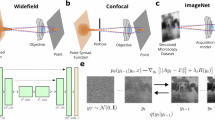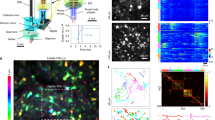Abstract
FOR many purposes, such as tracing networks of neural structure in the brain, a normal microscope has the serious limitation that only a thin layer of the specimen can be studied at one time, owing to the limited depth of focus of microscope objectives. When a thin section is examined, only those structures which happen to lie in the plane of the section can be observed. This plane may be confused by such objects as fibres coming away from or toward the plane of the section. A microscope which gave a large depth of field, and which presented the image as a solid in a luminous block in which the structures could be observed in depth would have important advantages over existing optical microscopes. We have designed and constructed a primitive prototype of an instrument giving such a ‘solid image’. It is possible to observe this from any position and to see the structures with appropriate parallax.
This is a preview of subscription content, access via your institution
Access options
Subscribe to this journal
Receive 51 print issues and online access
$199.00 per year
only $3.90 per issue
Buy this article
- Purchase on SpringerLink
- Instant access to full article PDF
Prices may be subject to local taxes which are calculated during checkout
Similar content being viewed by others
Author information
Authors and Affiliations
Rights and permissions
About this article
Cite this article
GREGORY, R., DONALDSON, P. A ‘Solid-Image’ Microscope. Nature 182, 1434 (1958). https://doi.org/10.1038/1821434a0
Issue date:
DOI: https://doi.org/10.1038/1821434a0
This article is cited by
-
A ‘Solid-Image’ Microscope
Nature (1959)
-
The Three-dimensional or Solid-Image Microscope
Nature (1959)



